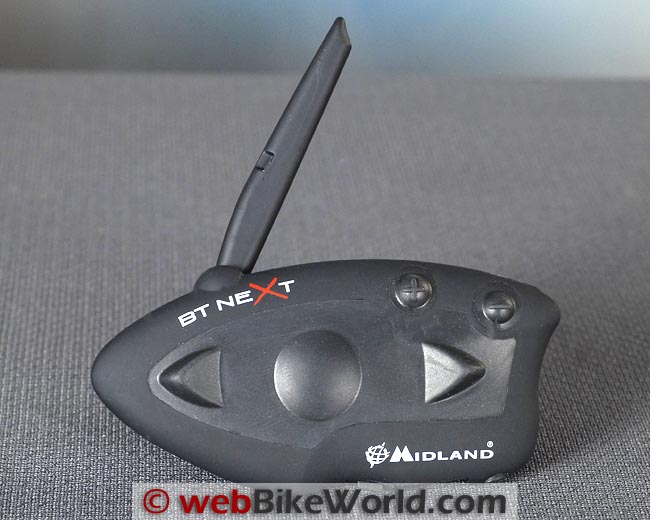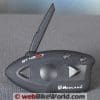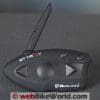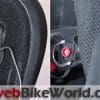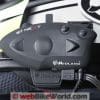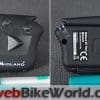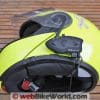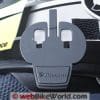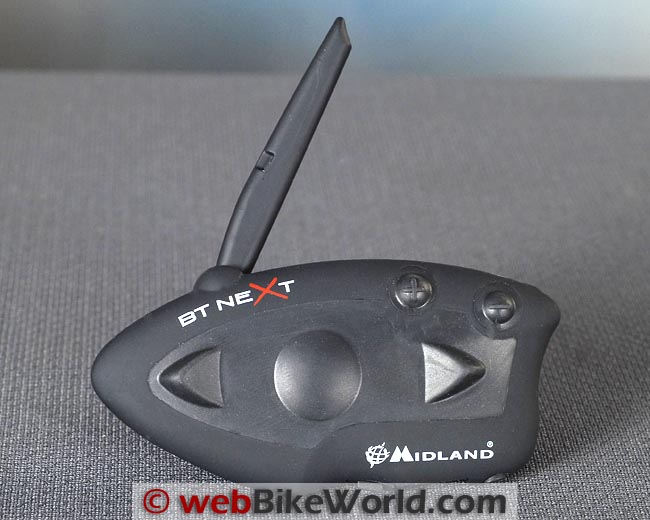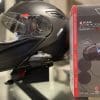Using the Midland BT Next system is a pleasure in every way.
Midland has truly brought the BT to the “Next” level.
Introduction to the Midland BT Next
Connectivity with multiple devices via primary and secondary Bluetooth inputs and a wired connection lets the Midland BT Next offer unmatched services for a stand-alone Bluetooth helmet communications system.
Slightly larger than its predecessors and very much “feature-rich”, the Midland BT Next remains a multi-faceted easy-to-use system, supporting simultaneous audio connections.
This allows primary devices to be monitored, while other devices stream their audio in stereo or mono concurrently in the background.
Intercom range under most conditions is on par with other leading systems and over varying terrain it outperforms the competition.
VOX functionality is seamless, with the feature offering user-configurable levels or manual operation. The AGC also works smoothly without the abrupt audio level changes experienced with other systems.
A stronger mounting assembly and an effective locking mechanism for the module resolves problems found with the original of the Midland intercoms.
Quality and quality control is evident everywhere, particularly in the modular construct of the robust headset that includes both a boom and thin-wire microphone.
The software package for firmware updates is well documented and sophisticated. The few minor hiccups found with the previous firmware installed have all been resolved with the March 7, 2012 update.
My previously cranky iPhone 4S running iOS 5.1 is now a perfect peripheral. I haven’t experienced one failure in peripheral pairing and switching nor mode functionality since installing the latest firmware.
It is hard to understate the advantages brought about by firmware updates; conflict resolution, feature additions and continued evolution of system capabilities to extend platform life and a continuing return on investment by owners.
Background
It has been over three years (November 2008) since the original EU-spec Midland BT2 intercom review was published on webBikeWorld and almost three years since the North American marketMidland BT2-D intercom systems (review) were evaluated — a long time, considering recent Bluetooth communications evolution.
Midland (Midland Radio Corporation in the US) is a long-term player in the mobile communications field around the world and offers up a diverse range of products, including my favourite models of two-way FRS/GMRS radios for the North American market.
My impressions of the first BT2 systems evaluated in 2008 were mixed, but I remained optimistic that Midland would realize the potential and make some fixes.
The follow-on evaluation of the BT2-D kit for the North American market showed progress, but work was still needed, especially in light of growing competition.
webBikeWorld reviews many Bluetooth-based products and thanks to the Editor I get to do my fair share.
And despite getting to use most of the newest products on the market, the Midland BT2 intercoms from 2008 were still in periodic use, especially as loaners so that other riders could discover the advantages of such devices.
Both the Editor and I had been tracking the release of the new Midland BT Next systems, among other new products from Midland, so when it was agreed to tackle the new systems I was a pretty eager beaver.
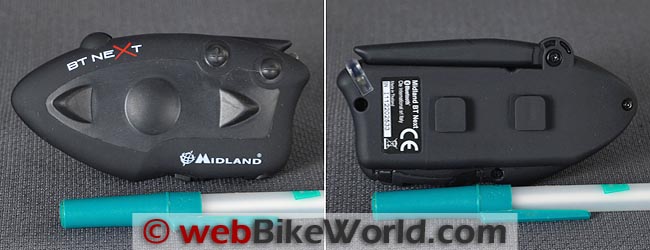
Midland BT Next Details
One of the Midland BT-series intercom features I like best is their stylized “rocket-ship” shape. Thankfully, that remains, although the BT Next module is a little larger and thicker that it once was.
It does have smoother edges though, with the main controls remaining distinctively shaped. And it’s smaller than a couple of other intercom systems we’ve reviewed.
Here is what’s inside the box:
- Two BT Next communication units (modules).
- Two audio sets (stereo speaker set, with boom and thin-wire microphone leads).
- Two bi-adhesive mounting plates.
- Two clamp mounting assemblies (inner and outer pieces).
- Two stereo audio cables (2.5 mm 4-pole to 3.5 mm 3-pole).
- One AC/DC power supply with double USB-Mini plugs.
- Two spare wind-suppressing foam microphone covers or “wind-socks”.
- Mounting components (Allen key and hook-and-loop strips for speakers and microphones).
Controls
Primary controls on the Midland BT Next intercoms consist of the raised round “Middle” button and the angular “Forward” and “Backward” buttons on the face. Secondary Volume (+) and Volume (–) buttons are located on the upper aft portion of the face.
The three primary controls identified above are multi-functional depending on which of the three main modes (Intercom, Phone and FM Radio) is active, with system mode and status commands generated by the new and very useful text-to-speech or “voice” feature.
The bottom of the unit retains three ports for connectivity.
The first port is a mini-USB jack for power and now, firmware updates; the middle port is the micro-USB interface for the headset; and, the rear port is the auxiliary 2.5 mm audio jack.
For optimal intercom performance an integral spring-loaded flip-up antenna has been added and it resides on the top inside edge of the module. A gentle push on the antenna allows it to pop-up and another push down and inwards latches it back into its recess.
The module release latch also works to keep the antenna secured.
Features
Running Bluetooth version 2.1, the BT Next system supports the Headset, Hands-free and Advanced Audio Distribution profiles (HSP/HFP/A2DP).
Automatic Gain Control or AGC provides automatic volume control for environmental or background noise while user-configurable VOX or voice-activation provides an option to manual communications using the microphone.
Designed to withstand rain and water, Midland does not provide an IP certification but does state that the “Midland BT Next is designed to withstand rain and water”.
For what it is worth, the rubber caps for the power/data and auxiliary ports need to be kept fully seated when not in use so module integrity is maintained, especially when those pop-up showers occur.
The non-replaceable lithium-ion battery is claimed to provide up to ten hours of talk time; a claim validated during use as it is possible to get two days or more of riding use out of the systems. Typical recharge time when fully discharged is around five to six hours.
Intercom link ranges of up to 1.6 km (1 mile) are claimed, based on use of the flip-up antenna and with a clear environmental field of view, otherwise known as line-of-sight. This claim has been more than validated.
Qualified compatible Bluetooth devices listed by Midland are mobile/smart phones with or without MP3 players; Garmin zumo models and TomTom Rider 1 and 2 navigation devices; and PMR 446 (FRS/GMRS) two-way radios (with or without Bluetooth) for group motorcycle to motorcycle communications.
The wired connection port can be activated or deactivated via the system or PC software.
It provides a convenient input for stereo audio input or a two-way radio connection as long as the appropriate accessory components are available (more on that later).
Coloured labels on the back of each module, one Black, one Red, provide easy identification between the two modules; a good standard being used on more and more systems, making it easy to differentiate rider, passenger or rider and rider modules which may have custom user configurations.
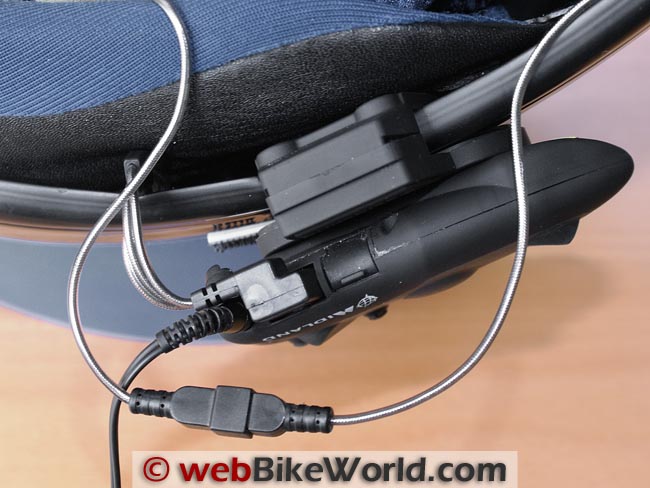
Midland BT Next Functional Basics
The Midland BT Next system, when used as a stand-alone intercom system, is more multi-functional than most other Bluetooth motorcycle intercom systems on the market right now.
Accordingly, there are more configuration options, but the controls are easy to understand and use thanks in large part to a very well written and multi-language Instruction Guide (available as a downloadable .pdf).
Holding the Middle button for three seconds initiates power-up with a musical Power On sequence heard, loudly, in the headset and a voice announcement identifying the current mode.
Holding the Middle and Backward buttons for three seconds initiates power off. The Midland BT Next has, thankfully, retained the primary and secondary pairing options of previous versions. In some ways it is like having two separate Bluetooth mediums to utilize or an external hub adapter…
Pairings via Volume+ (Primary)
Devices paired using this control have the highest audio priority on the system and this medium is best used for mobile/smart phone or multi-function GPS devices that provide A2DP/AVRCP services along with HFP functionality.
Pairings via Volume- (Secondary)
To take full advantage of the multi-connect, multi-channel and (multipoint?) features of the system, Midland recommends headset/hands-free (HFP) pairings using this control. The reason: audio from devices paired via this option stream in the background, without interrupting other audio, like the intercom.
But there is a limitation — mobile phones or A2DP capable devices can’t be paired via the Volume- button, unless an external hub is used or a GPS host is added.
So when a GPS host is present, the mobile phone is paired to the multi-function GPS device, itself paired via Volume- on the Next. Navigation audio and phone calls will now be in the background and will not interrupt the intercom.
Another configuration based on optional components allows a FRS/GMRS two-way radio to be paired with a compatible PTT/Radio interface lead using the 2.5 mm auxiliary input port or wirelessly if the radio is Bluetooth equipped (some Euro Spec PMR446 units are).
With this optional configuration in place an external hub or adapter, like the Sena SR10 (review), is not needed for radio connectivity and control.
Intercom Use
The two BT Next intercom modules were paired at the factory, but it’s easy to do if required.
Manual intercom activation just takes a press of the assigned activation button. Within three seconds the link opens, indicated by a low click, a beep and very faint white noise that is typically but only audible in very quiet settings.
If VOX mode is active waiting 40 seconds (original firmware setting was 20 seconds) with silence results in automatic termination of the session indicated by a double beep.
Temporarily disabling VOX can be done on the fly by pressing the Backward button for seven seconds; a double tone beep indicates VOX is disabled. Repeating this step brings a single tone beep indicating VOX is active again.
Configuring VOX from a system perspective: on, off and sensitivity settings can be done via Setup Mode, the Backward button and the Volume Up and Down controls. This feature, along with all other adjustments can be made via the PC interface as well.
For intercom purposes, VOX is only available when the Middle button is the activation control. Intercom pairings done using the Forward and Backward buttons must be managed manually.
And speaking of compatibility, the BT Next system can be used with previous Midland BT1 and BT2 units by just using the applicable intercom pairing steps for each model. Don’t forget the respective intercom ranges of the different systems need to be kept in mind…
Up to three additional compatible Midland BT systems can be paired together for one to one intercom communications, using each of the three primary buttons for the respective pair assignments.
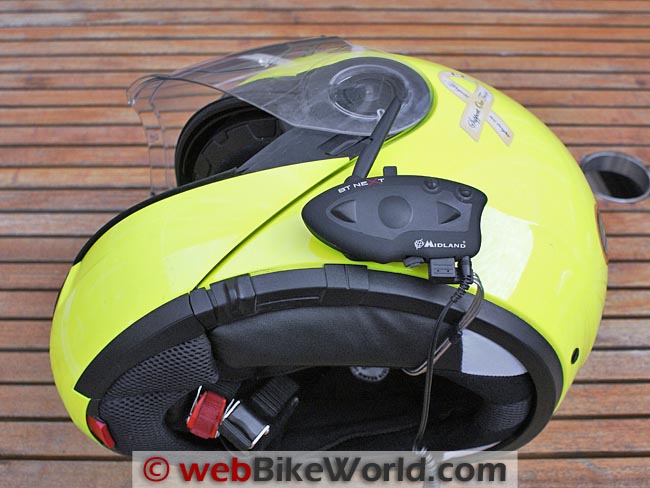
BT Next Bluetooth Adapter Compatibility
This is a new section for the webBikeWorld Bluetooth motorcycle intercom system reviews, but long overdue in many respects and hopefully as we journey through 2012 and beyond there will be more components on the market that can be looked at from this perspective.
For now, there are just two, at least that we have on hand, for evaluation with various BT helmet or personal systems: the Sena SR10 (review) and the UClear WT300 “Spider” (review), that readers were first introduced to from the 2012 Dealer Expo (report). Two are currently undergoing evaluation.
As only the Sena SR10 units have seen extensive use with the BT Next systems, they are the focus at this time. Putting the Midland BT Next intercom into Setup Mode (solid Red LED) and pushing the Volume- button for three seconds starts the Blue/Red LED sequence.
With the Sena SR10 turned on, hold its Phone button for five seconds to initiate pairing mode. It didn’t take long (24 and 19 seconds respectively) to get the two Midland systems paired up with their SR10 counterparts — done individually, of course and with one set turned off to prevent unwanted interaction from the other.
With a two-way radio connected to each SR10 and set to the same channel and sub-channel, pressing the PTT on one of the SR10 units resulted in a two-way radio link being established in two seconds flat.
After a two-way radio session ends (no keying), the SR10 closes the link after five seconds and goes to Standby mode, indicated by a steady Blue LED first, then resumption of its slow pulsing. From this point in time, the intercom on the Midland BT Next system is now available.
But this is where the VOX feature of the BT Next system can become slightly intrusive, if not managed, as illustrated by the following scenario.
If module One uses the Middle button for intercom pairing with module Two and if both modules are on and if VOX is active, pushing the PTT button for a two-way radio session also activates the intercom link, based on voice input through the microphone triggering the VOX circuitry.
If you want the module Two user (like the passenger) to be able to hear the two-way radio session this works well, but if not, there are alternatives.
The first is implemented by pairing module One with module Two using either the Forward or Rear button which serves to remove VOX from the function picture, as it only works with the Middle button assignment.
A second alternative is to just disable VOX — temporarily or otherwise — allowing the Middle button to be used for intercom pairing yet not activate the VOX circuitry when the microphone is used for a two-way radio session.
The BT Next intercoms, when combined with the Sena SR10 hub adapter, provide additional functionality that is hard to duplicate on most system — even those with Bluetooth 3.0 and Multipoint.
While the Sena SMH10 V4 firmware now provides a concurrent or background audio capability, the BT Next has done this from day one; anything paired using the Volume- channel remains active as background audio.
In essence, this is the same approach used by the Sena SR10 itself in mixing all active audio inputs into one audio stream to the paired headset, but the BT Next does it internally.
This means that while you have background music coming in via the wired connection, the BT Next intercom can be used with other paired systems, and pressing the PTT switch on the SR10 initiates a two-way radio link for communications with multiple riders, with all audio perfectly balanced.
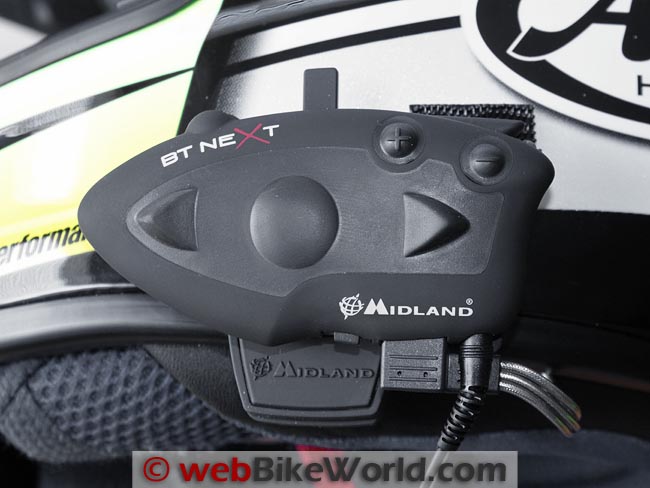
Midland BT Next Power Management
Like most Bluetooth motorcycle intercom systems, the BT Next modules are charged via the AC/DC charger or trickle-charged from a PC USB port with the common connection being the USB cable.
Like the Sena devices, the BT Next modules can be charged on the move, if the motorcycle is equipped with the appropriate power output port or adapter.
Installing the Midland BT Next
The first two candidate helmets for the BT Next were the well-travelled and well-worn Nolan N-103 (review) and my equally well-used and favoured SCHUBERTH C3 (review) in hi-vis yellow. Flip-up helmets can be a challenge for mounting some intercom systems so this is a good test.
At 3 3mm x 7 mm (diameter x thickness), the lightweight ultra-flat stereo hi-fi speakers provided with the Midland BT Next intercoms are easy to install — helmet speaker recesses or not.
Each speaker sits inside a removable 50 mm diameter fabric housing with a “hook” backing that will adhere to brushed liners in many helmets, with companion roundels provided in the accessory kit for as needed.
The modular headset features a micro-USB jack with three heavy-duty shielded wire leads; one for the microphone and one each for the left and right speakers. The microphone and right speaker leads use heavy-duty modular dual-pin connectors.
The entire harness provided with the BT Next is one of the most robust assemblies used on a commercial helmet system.
Nolan N-103
with some slight pressure the speakers housings fit almost flat in the liner recesses with the heavy duty shielded wire leads easily routed and secured out of the way.
The 23 cm (9.055 in.) long boom microphone component takes the most effort, but thanks to the molded channel at the front of the shell intended for the Nolan N-Com boom, the assembly is mounted quite securely with the adhesive plate adhered to the inside of the shell.
SCHUBERTH C3
The C3 has a smaller shell helmet that is more compact than the Nolan, so the SCHUBERTH installation took a few minutes longer mainly due to the time spent in removing the SRCS collar and headset and replacing it with the standard collar and then unsnapping the cheek pads.
The Midland speaker housings fit almost flush in the elongated recesses that allow precise placement in fitting and positioning speakers for users. The boom microphone is long enough but careful routing is needed to keep it clear of the heavy wire ring of the collar.
With the collar cushion in place and the cheek pads snapped back in, the boom and microphone, with some adjustments for proper placement in front of the mouth, was quite secure without using the adhesive.
I used the adhesive fixing plates on both helmets. These were positioned just behind the flip juncture so as to clear the respective sun-visor slider controls, which is likely to be more of an issue on some of the newer flip helmets like the new Nolan N-104 (review).
After letting the adhesive “cure” overnight, aligning the BT Next modules with the cut-outs, pressing the modules inwards slightly and then down locks them into place with a distinctive snap.
Locked in place, the module can be wiggled slightly due to tolerances, but compared to the original mount that was demonstrably weak these modules are not going anywhere. It takes a fair bit of effort to even disengage the module with the release latch pushed inwards for removal purposes.
The fixing plate itself is larger and thicker than the original BT2 intercoms.
The adhesive backing with its thicker sponge layer overcomes surface differences in shell and bottom edge sections, providing a very solid mount. It is the best stock adhesive mount I have used.
Subsequent installations on the venerable Arai XD3 (review) and other full-face helmets saw the screw clamp assembly used and the boom microphone replaced by the 26 cm (10.23 in.) long thin-wire component. The clamp and rear plate are styled with smooth lines but again thicker and heavier than the original BT pieces.
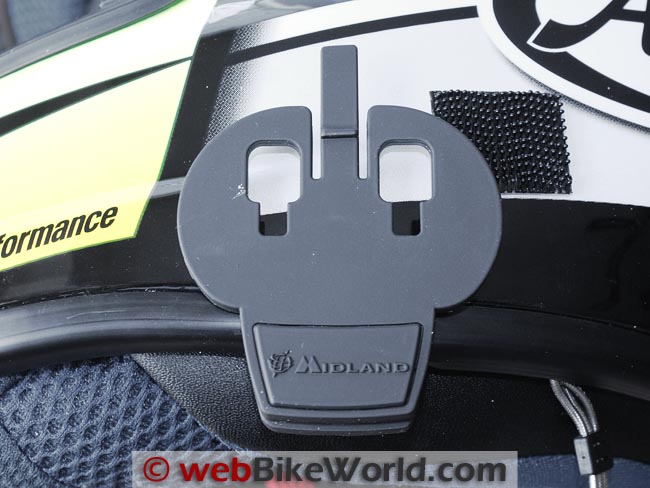
Midland BT Next: On the Road
The first test ride through the rolling hills of Virginia proved one thing: the Midland BT Next system makes an outstanding first impression.
Other than two volume adjustments (one done before starting off and the other once on the highway), no other adjustments were needed.
The AGC maintained audio levels under noisy cockpit conditions (due to severe cross winds) and the default VOX setting (Medium) was just about perfect inside the XD and XD3 helmets.
With VOX adjusted for riding and helmet environments, stating a couple of words loudly as a precursor triggers the circuit and activates an intercom link within three seconds, with virtually no noise evident on the circuit.
Manual activation works just as well. No muss, no fuss, just function, with excellent audio clarity.
At lower speeds on back roads and in trolling through towns there is no discernible background noise although there is a very slight “click” audible when circuit switching takes place, but it is totally non-intrusive.
On average, five to six hours of almost constant intercom use with some music streaming results in a 35- to 45- minute recharge cycle, indicated by the steady-on Blue light. The systems have been used for as long as a period of three days (intercom and navigation audio) before requiring a charge.
Depending on the ride and requirements, connectivity options will change, although the basic standalone setup has the Midland BT Next systems paired for intercom use, the smart phone on Primary and the GPS on Secondary Bluetooth, with a music device connected by wire.
If more options are needed, including two-way radio communications, the Sena SR10 is paired via the Secondary allowing additional peripherals like the GPS (Aux 1), the two-way radio capability, and sometimes a secondary (on-call) mobile phone (Aux 2).
Intercom links of well over 1000 to 1200 meters are solid, over hill and dale. Longer link ranges, out to 1500 and 1600 meters, are easily obtained when terrain is flat and an extended line of sight is provided.
For variety or when needed, a two-way radio link pushes communication ranges out considerably farther and all while listening to stereo music and/or GPS navigation instructions in the background.
A smart device paired via Volume+ provides another stereo music streaming option and concurrent monitoring of the primary phone. Yes, silence can indeed be golden and on many rides, everything is put on standby so nothing but rushing air and moto noise is heard, all properly dampened by good ear protection of course.
But using communication and entertainment resources in a safe and virtually hands-free environment is something I can live with, but only when it can be done without losing situational awareness and negatively impacting safety.
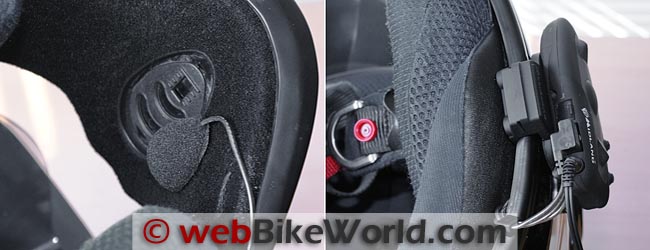
Midland BT Next Firmware Updater
Without a doubt, the Midland BT Next Updater PC application is the most effortless and the most comprehensive I have seen so far, largely due to the many features of the device itself.
The current Midland Updater application is version 0.9 BETA and it is currently available for download. Make sure you download all essential files — two .pdf documents, the Updater application and the zipped firmware file.
Only Microsoft Windows XP and Windows 7 (32 or 64 bit versions) are supported at the current time.
Once downloaded, the file should be installed using administrator privileges. With the application installed and the required drivers installed (see below), launching the app will bring up the initial screen with the main interface tiles highlighted, but grayed out, until a device connection is made.
A button in the upper right corner lets the user select between English, German, Italian or Spanish as the interface language.
Although software applications for firmware support is rapidly becoming a de-facto standard, the Midland experience is sufficiently different so as to warrant a closer look.
Midland BT Next Intercom Ratings and Observations
Audio: As streamed, audio via the headset is outstanding and near the top of my list, even though the speakers are small and lightweight compared to some other headsets.
FM Radio: Exceptional performance from my perspective. Once the setup steps are practised and stations tuned (from device or via PC interface) a dynamic and stable listening option is provided.
The RDS (Radio Data System) or auto-tuning feature is off by default, but in some environments it provides advantages.
Firmware: Version 28-7-2011 resolved all the hiccups I had observed regarding A2DP/AVRCP and Volume- pairing. My iPhone 4S running iOS 5.1 is working perfectly. Voice Control and SIRI input sits at about 97% accuracy. Advantage BT Next.
Intercom: Under typical conditions, the BT Next intercom range is on par with that of the Sena SMH10 and better under varying terrain (hills, curves, switchbacks).
Although the Interphone F5 (review) seems to have the upper hand over both the Sena and the BT Next (but more on that in the F5 Part 2 coming soon). Advantage BT Next.
Connectivity: Multi-device, multi-channel and (multipoint) capabilities provide better flexibility than the SMH10, the F5 and others, without an external hub/adapter. Advantage BT Next.
Switching: Intercom and connected two-way radio communications switching is seamless.
Conclusion
Over the past three months, the Midland BT Next intercom systems have been used whenever possible — typically interchangeably with the Sena SMH10 and now with a pair of the Interphone F5 Intercom systems that are being evaluated for their Part 2 follow-up.
Even with the Sena V4 firmware update (report), implementation of Bluetooth 3.0 and other functional enhancements and compared to the Interphone F5, the Midland BT Next continues to more than hold its own regarding features, functionality and reliability.
It performs as advertised and then some.
If Midland implements Bluetooth version 3.0 for improved system management, better bandwidth, longer battery life and more sophisticated switching, it will be one hard-to-beat motorcycle communications system.
Owner Comments and Feedback
See details on submitting comments.
From “K.J.” (August 2015): “Just now I found your review of the Midland BT Next. I bought one just over a year ago, and had trouble using it with the Garmin Zumo 590, as a friend had trouble using it with the BMW Navigator (4 I think).
Problems are poor sound quality and disturbed reception. Besides that, water gets in when riding in wet conditions!
Midland replaced my unit 3 times (!!), and when it failed again replaced it with a BT Next Conference. It was not a known issue, but still the sealing was improved, the wrote.
But again, I have many problems using it with my Zumo 590, and again it fails when riding in wet conditions.
Did you ever use the BT Next with the Garmin Zumo 590? It can work fine for hours, even a day at times. But it can fail several times within only 15 minutes. It can be very frustrating, causing me to be distracted which can lead to dangerous situations!
I have to admit Midland has (up to now, I have not heard from them for 2 weeks since my latest complaint) is very committed to help me. But has failed to provide me with a good solution up to now.
Garmin does not seems to care at all, send a small list of Bluetooth devices they support, and that’s final.
I use the BT at least 3 days a week, consider myself a frequent rider. In all weather I may add.”
UPDATE From “K.J.” (August 2015): “Small addition: I got my Sena 20S (review) and used it for a week (about 6 hours). Works perfectly with the Zumo 590!
Sound quality is slightly less than the Midland (can maybe be improved by bringing the speakers closer to the ears with provided fillers).
But at least it works right away; the Midland can take minutes and minutes to connect or fail needing a reset of the Bluetooth connection on the Zumo.
And the Sena (so far) never loses connection, degrades the connection. Besides the Sena can be used while charging (great during long rides and holidays).”
From “Y.M.” (May 2014): “We bought a BT Next (rider & pillion), it was great for the first few rides. Now it keeps switching off even when we are talking. We don’t have it paired with anything else. It beeps, goes silent and eventually beeps and comes on again. Sometimes not at all.
My husband went out on his own and used the Zumo sat nav which worked well, then just turned off and never came on again. The units were fully charged so that’s not the problem.
The shop want to send (the) units to (the) manufacturer and don’t want to replace/refund yet, we have had this less than a month and reported the fault after less then 3 weeks. What to do?”
From “L.S.” (July 2013): “I’m interested in the Sena SM10 Bluetooth Transmitter (review) for GPS+Music configuration.
When you tested it with Midland BT Next, did you paired it with Vol+ button or Vol- button? The BT Next manual says that audio from “Vol- connected devices” stays in background while talking through intercom. Does that work in stereo too? If so, rider and passenger could talk together while listening to the same music!”
H.B.C.’s Reply: Using the Sena SM10 for A2DP via Audio In and navigation audio via the AUX input makes for a good configuration, but there are a couple of conditions regarding the BT NeXt system (version 1 at least) that apply here:
1. You want to pair a device for A2DP streaming, like the SM10, using the Volume + button. Devices can be paired on Volume- as background audio, even during intercom sessions, but they will be mono (Headset/Hands-free).
The following extract is from the review: Pairings via Volume- (Secondary) To take full advantage of the multi-connect, multi-channel and (multipoint?) features of the system, Midland recommends headset/hands-free (HFP) pairings using this control. The reason: audio from devices paired via this option stream in the background, without interrupting other audio, like the intercom.
But there is a limitation; mobile phones or A2DP capable devices can’t be paired via the Volume- button, unless an external hub is used or a GPS host is added. So when a GPS host is present, the mobile phone is paired to the multi-function GPS device, itself paired via Volume- on the Midland BT Next. Navigation audio and phone calls will now be in the background and will not interrupt the intercom.
2. So if a device like the SM10 is to be used, in essence an external hub with A2DP, and even if paired using the Volume+ button that supports A2DP streaming, a second condition, also eluded to in the evaluation puts another limitation in the way, as stated in the V1 manual: “Intercom – The Intercom has always a higher priority against the music from the FM Radio or Phone (including GPS in music play mode). Every time you open the intercom the music from a Bluetooth source is stopped. Only the audio/Music from the ‘AUX wired connection’ is always in background by default.”
So while the SM10 can be successfully paired to the BT NeXt using Volume+ (I did some testing with it today again with some other devices), the following scenario describes what happens:
If the SM10 is paired using the Volume+ on both headsets, allowing streamed audio to be shared, it will only be heard in the headsets initially if Phone mode is selected (you may have to each tap the Middle/Main button to activate the audio in the headset.
If the rider wants to initiate an intercom session, that mode needs to be selected, which based on the system priorities described above will stop the music streaming to both headsets once the intercom link is active. If the passenger ends the intercom session, the music will resume typically within five seconds to both headsets, but if the rider ends the intercom session, the audio sharing will resume to the passenger, but not the rider, who will have to change the headset to Phone mode again to get the streaming.
Some exceptions to all of this have been noted, so I am still working with the baseline configuration to see if any other observations will fall out.
But acknowledging that the BT NeXt in its original form was an extremely good system with the ability to multi-task matched by few others, the original feature have, to a large degree been taken over: the BT NeXt V2 has added a few features and will now even pair with two non-Midland BT headsets (hopefully we will get a chance to review the V2 systems soon).
And the firmware features found on current Sena models are equally adaptive and versatile, particularly the Selective Pairing abilities that come close, and even surpass in some ways, the initial capabilities of the BT NeXt V1.
Now on the scene, of course, is integrated Music Sharing, courtesy of the new Cardo Scala Rider Q1 and Q3 systems and in having just completed the evaluation for webBikeWorld I can say unreservedly that this music sharing implementation works extremely well.
It’s fast with outstanding audio, although again, the basics of Bluetooth are still primary and once higher priority audio comes in sharing ends and it must be manually restarted…not perfect, but it provides an onboard and very viable option for music sharing – a feature that can only get better.
From “C.W.” (December 2012): “Thank you for the excellent review of the Midland BT Next. This comment relates to the Midland G8 Bluetooth Radio when used in Bluetooth mode
In November 2012 I purchased a BT Next and a Midland G8 BT to use on my forthcoming motorcycle holiday in Northern Thailand. It soon became apparent that G8 was only capable of producing such low volume levels in Bluetooth mode that it was impossible to hear a conversation via the PMR radio while riding along. I contacted Steve Read at Alan UK (The UK importers at the time) to be told that this was a known problem and that the radio would have to be sent back to Italy for modification.
The radio was sent back to Alan UK and I eventually received it back after my motorcycle trip. This was complicated by the change of UK importer to Nevada Radio.
The Bluetooth radio volume was much improved but sill not as loud as my Nokia phone when used with the headset. I have a college who expressed an interest in purchasing as similar BT Next Midland GB BT set up for his bike. I contacted Paul in retail sales at Nevada Radio in September to ask if the problem with the radios has been resolved. I received no reply so I resent the email on 10th September 2012 and received the following reply a day later.
It would appear that currently available G8 BT radio, explicitly advertised for motorcycle communication via Bluetooth, are not suitable for purpose. I feel that your readers should be made aware of this problem.”
From “C.B.” (June 2012): “I bought the BT Next about a week ago based on the stellar reviews and I had a mixed reaction to the unit once it was installed in my Arai RX-Q (review).
First off, the installation was a breeze. I just pulled out the liner, ran all of the wires, hooked everything up and I was ready to roll. I have an ’07 ZZR 600 with a Two Brothers aftermarket pipe, so the exhaust note is pretty intrusive (good intrusive, just hard to ignore) so I rarely ride without earplugs.
With earplugs in, the volume on the BT NExt wasn’t adequate at all. I could hear it but the audio quality was so faint, it wasn’t worth the effort. I then tried it without earplugs, which worked great at low speeds but was worthless for anything above 50 mph.
The quality of the music and radio were just too bad to use and the exhaust note and wind noise were irritating. I would have scrapped the whole thing if it weren’t for the fact that the call quality on the cell phone was outstanding. Despite doing 70 down the freeway, with all the noise I just described, my wife couldn’t hear any background noise and wouldn’t have know I was on my bike if I hadn’t told her.
To make it work for me, I decided to make a modification to the unit. To listen to music prior to the BT Next, I was using a pair of Klipsch S4 headphones plugged into my iPhone. I got the great audio quality, the ambient noise was under control and, as long as I didn’t turn up the volume too much, I could still hear traffic around me, or at least hear when somebody honked, or hear emergency sirens.
I pretty quickly decided to try and splice my S4s to the BT Next to get the system I’d hoped to have in the first place.
After playing around with the unit with a pair of the Apple earbuds I had lying around, I discovered that I could get audio out by touching the earbud leads to the connection points on the BT Next speakers, so I clipped the speaker leads from the BT NEXT and soldered on the S4 earbuds. It was a bit of a hassle, mainly because both the BT Next and S4 use extremely small conductive wire wrapped in acrylic thread so I needed to find a way to isolate the conductor.
After heating the wire tips carefully over my gas range burner, I was able to melt away the thread enough and get to the bare metal conductor on each wire without damaging the wire insulator too badly. I soldered it all together, used some shrink wrap tubing and electrical tape to insulate everything, and it worked.
When not in use, I can tuck the S4 earbuds into the neck liner on the RX-Q and use conventional earplugs without having wires dangling everywhere.
Given all the great reviews for the BT Next, I’ve got to assume that people are riding bikes that have either better wind/noise protection, or they have the hearing of a bat. I know out-of-the-box, the BT Next was unusable for me. After a few minutes of creative soldering, it’s exactly what I’d hoped it would be.”
H.B.C.’s Reply: Having ridden more than my share of race machines and accessory-piped street machines, this by itself is (probably) the primary issue, even though would might expect that the relatively closed helmet environment and close proximity headsets would overcome — they don’t, trust me.
The other point I must make is that hearing loss is a huge and growing medical issue today (among many), primarily due to where we live, how we live and what we live with in the way of devices and pounding audio. So while one is a fact, the other could be or is a factor and it would all help explain this users assessment.
I must admit that the Midland BT Next system does not have the same “total” output of the new Sena systems or the G9, but it is still very capable of generating pain in my ears — off the motorcycle or on the road, although not at the highest speeds on the noisiest machine, where it still remain useable.
I use the BT Next systems on a lot of different motorcycles at speeds from street to ++ and have never really found the audio output lacking — but again, this is my assessment and totally subjective, of course.
From “W.K.” (May 2012): “Nice to see a review of the Midland BT Next. It happens so that I have been using the BT Next for about 3 months now as a follow up for the Interphone F3 (review).
Make sure you have the latest firmware. Right now there is a firmware available from March 2012. It made a big difference in my case. Also the upgrade program is not in Beta stage anymore.
For me and my wife I bought the duo set of the Midland BT Next. The reason mainly was to have better music control (there was only play and pause on the F3), no more stutter or interference when playing Bluetooth audio (like I had on the Interphone F3) and the possibility to do firmware upgrades. All these reasons were present in the Midland set and for a very good price!
Because it is a duo set, I have 2 units. One unit (of course the one on my helmet… ;( ) gave me a lot of troubles. It would get stuck in a mode and I wasn’t able to get it out of this mode (this happened of course on a long motor weekend out of country.. ) So no music of navigation audio. That really pissed me off of course.
I called the shop and they were offering me another unit but also asked me to first do the firmware update. The firmware update solved that and some other problems I was experiencing. For me the settings in the units needs to be VOX off and the speakers on High. This because we both thought that the volume of the Intercom on the highway wasn’t loud enough (we both wear earplugs).
Because of the ability to tune your device using software on the computer it is possible to set up the Midland just the way you like!
I also very much like the speediness of the reconnection of the Intercom. This works great! Range is so, so in the Netherlands because of the many, many houses we have here… And I’m not very impressed with the radio reception. But it does gets the job done and the nice thing is that the radio goes to the background when navigation instructions are spoken.
To sum it up: I think the Interphone F3 had louder audio but that was the only advantage. ;)”


